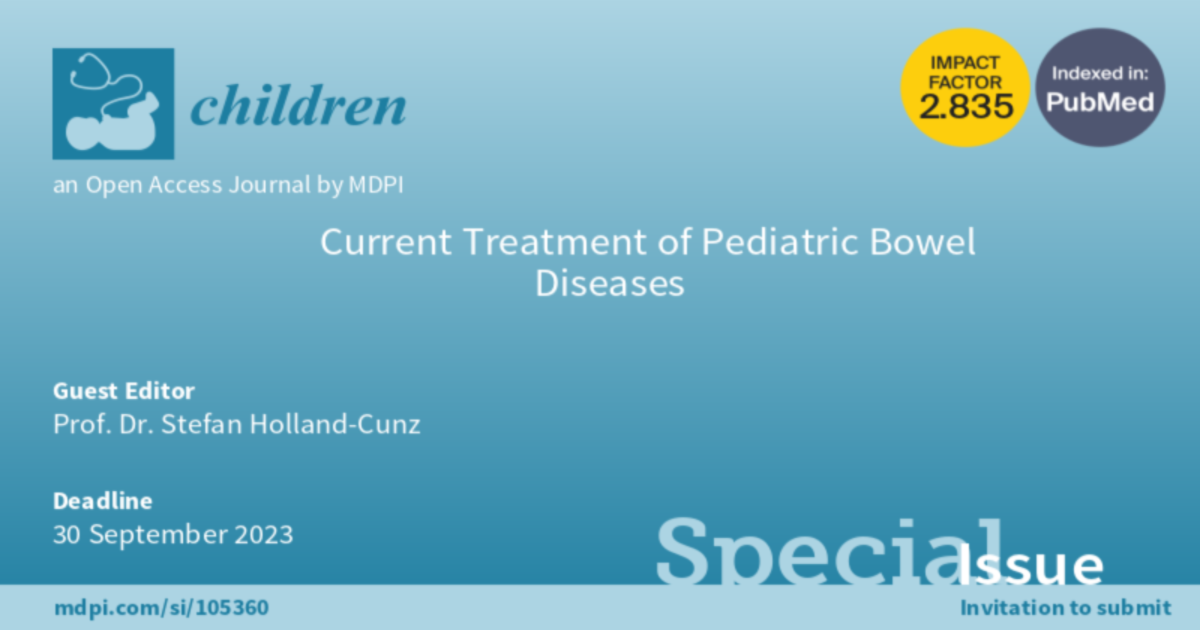Current Treatment of Pediatric Bowel Diseases
A special issue of Children (ISSN 2227-9067). This special issue belongs to the section "Pediatric Gastroenterology and Nutrition".
Deadline for manuscript submissions: closed (30 September 2023) | Viewed by 14046

Special Issue Editor
Special Issue Information
Dear Colleagues,
Pediatric bowel diseases include a broad spectrum of inborn and acquired disorders with a high impact on quality of life.
Treatment guidelines for pediatric bowel diseases are often missing due to limited evidence. This Special Issue intends to give the reader an update on pediatric bowel disorders with a special focus on surgical and non-surgical treatment options as well as the transition period from childhood to adulthood.
Clinical, basic science, and translational studies related to pediatric bowel diseases are welcome.
What kind of papers we are soliciting: Studies addressing pathophysiology, epidemiology, and/or treatment (including confirmation or refutation of conventional therapies, novel treatments, and treatment guidelines) are highly appreciated.
Prof. Dr. Stefan Holland-Cunz
Guest Editor
Manuscript Submission Information
Manuscripts should be submitted online at www.mdpi.com by registering and logging in to this website. Once you are registered, click here to go to the submission form. Manuscripts can be submitted until the deadline. All submissions that pass pre-check are peer-reviewed. Accepted papers will be published continuously in the journal (as soon as accepted) and will be listed together on the special issue website. Research articles, review articles as well as short communications are invited. For planned papers, a title and short abstract (about 100 words) can be sent to the Editorial Office for announcement on this website.
Submitted manuscripts should not have been published previously, nor be under consideration for publication elsewhere (except conference proceedings papers). All manuscripts are thoroughly refereed through a single-blind peer-review process. A guide for authors and other relevant information for submission of manuscripts is available on the Instructions for Authors page. Children is an international peer-reviewed open access monthly journal published by MDPI.
Please visit the Instructions for Authors page before submitting a manuscript. The Article Processing Charge (APC) for publication in this open access journal is 2400 CHF (Swiss Francs). Submitted papers should be well formatted and use good English. Authors may use MDPI's English editing service prior to publication or during author revisions.
Keywords
- newborn
- child
- intestine
- disease
- surgery
- treatment
Benefits of Publishing in a Special Issue
- Ease of navigation: Grouping papers by topic helps scholars navigate broad scope journals more efficiently.
- Greater discoverability: Special Issues support the reach and impact of scientific research. Articles in Special Issues are more discoverable and cited more frequently.
- Expansion of research network: Special Issues facilitate connections among authors, fostering scientific collaborations.
- External promotion: Articles in Special Issues are often promoted through the journal's social media, increasing their visibility.
- e-Book format: Special Issues with more than 10 articles can be published as dedicated e-books, ensuring wide and rapid dissemination.
Further information on MDPI's Special Issue policies can be found here.






